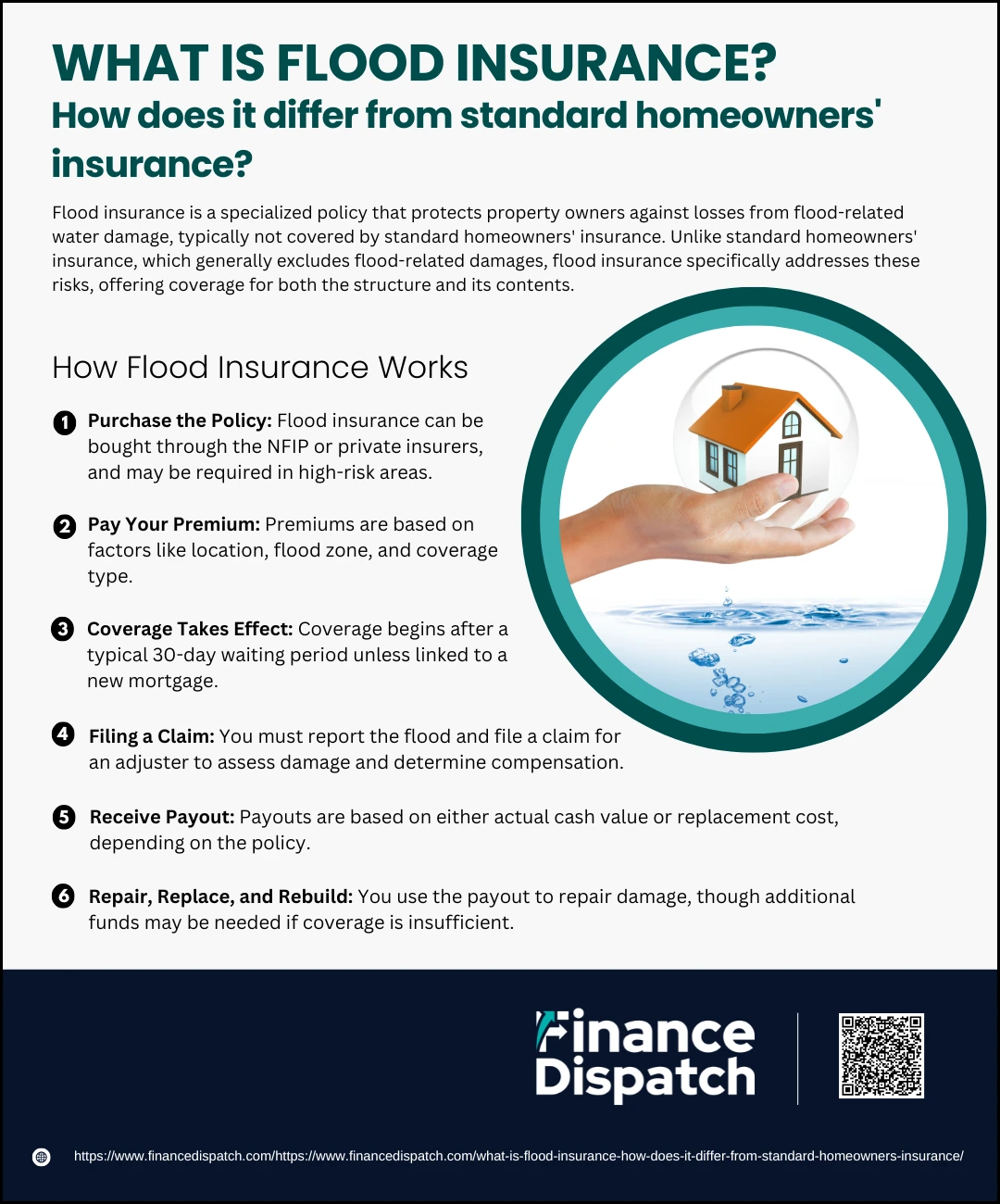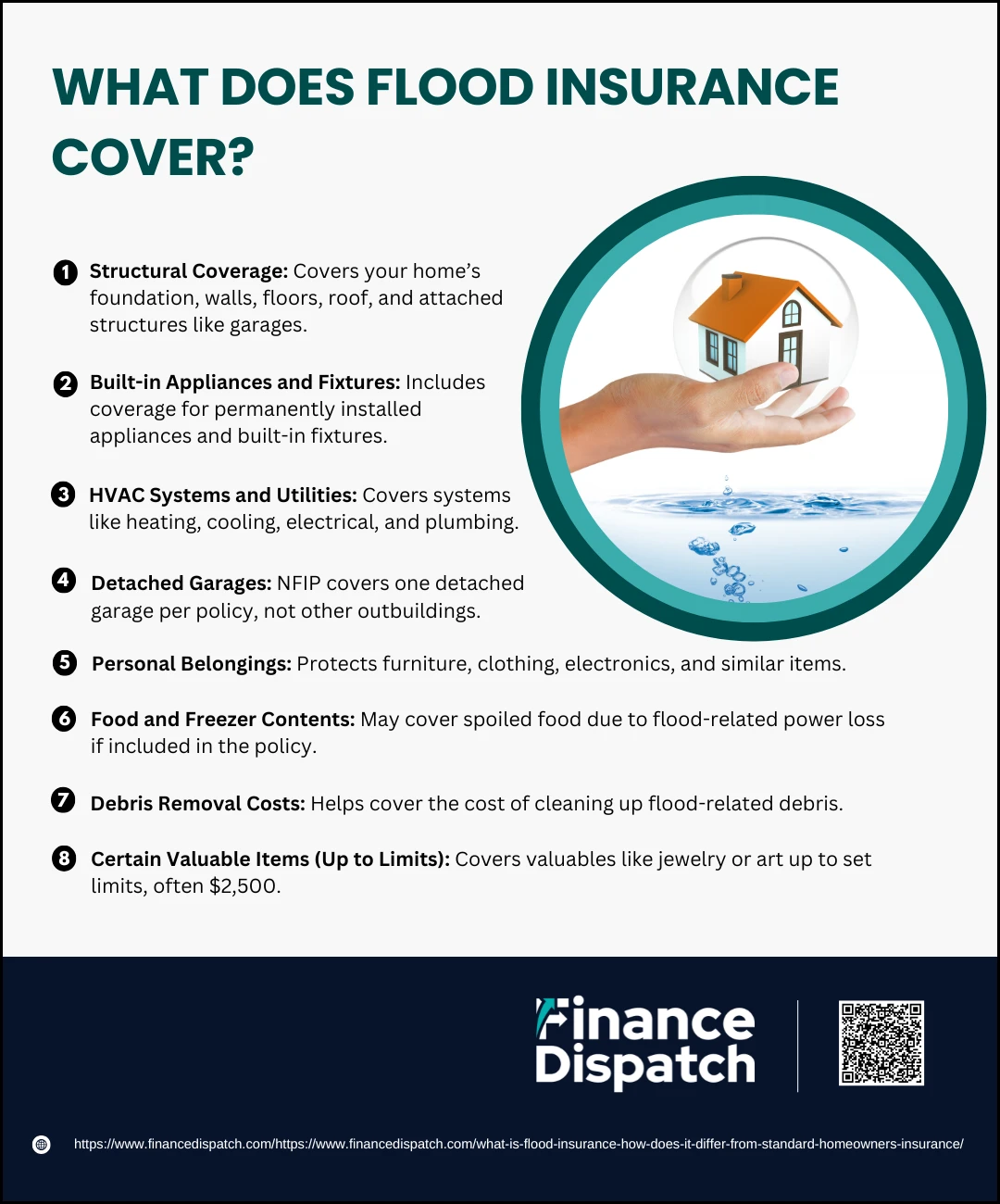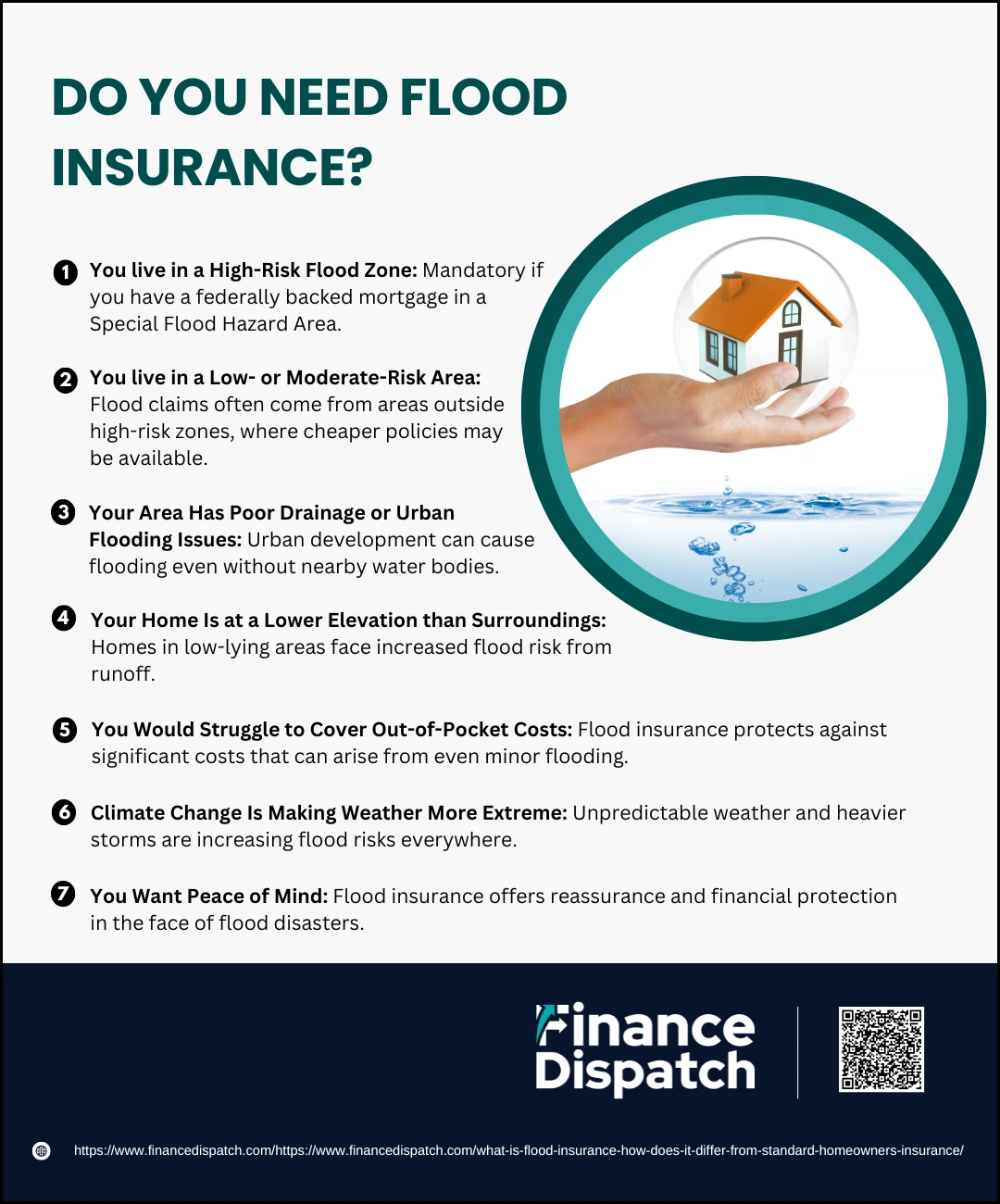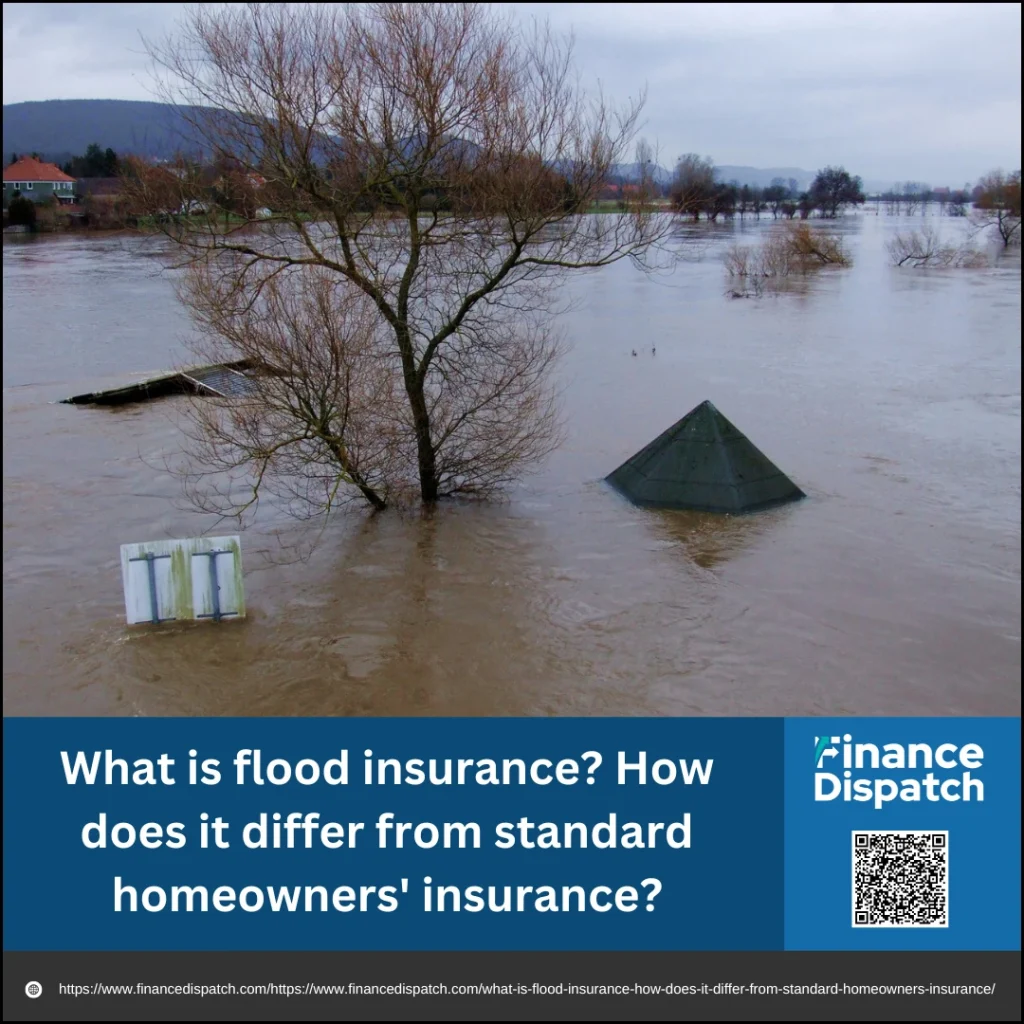Your home is one of your most valuable investments, and protecting it from unexpected disasters is a top priority. While most homeowners believe their standard insurance policy has them covered, there’s one major gap that often goes unnoticed—flood damage. Contrary to popular belief, typical homeowners’ insurance does not include protection against flooding caused by natural events like heavy rain, overflowing rivers, or storm surges. That’s where flood insurance comes in. In this article, we’ll break down what flood insurance is, how it works, and how it differs from your standard homeowners’ policy—so you can make informed decisions about safeguarding your property and peace of mind.
What Is Flood Insurance?
Flood insurance is a specialized type of property insurance designed to cover losses and damage specifically caused by flooding. Unlike general homeowners’ insurance, which covers internal water issues like burst pipes or appliance leaks, flood insurance protects against external water events—such as heavy rainfall, overflowing rivers, coastal storm surges, or rapidly melting snow—that inundate normally dry land. This coverage can apply to both the structure of your home and its contents, depending on the type of policy you choose. Since floods can cause extensive and costly damage, having flood insurance ensures you’re financially protected when disaster strikes, especially in areas prone to such events.
 How Flood Insurance Works
How Flood Insurance Works
Flood insurance operates as a safety net for homeowners, renters, and business owners, providing financial protection against water damage specifically caused by flooding events. Since standard homeowners’ insurance typically excludes flood-related damages, a separate flood policy becomes essential—especially in areas prone to storms, heavy rain, or rising water levels. Flood insurance policies are usually offered through the National Flood Insurance Program (NFIP), which is managed by FEMA, or through private insurers. The process is straightforward, but there are some important steps to understand before and after a flood event.
Here’s a breakdown of how flood insurance works:
1. Purchase the Policy
You can buy flood insurance through an insurance agent or company that participates in the NFIP, or through a private insurer. You don’t need to live in a high-risk area to qualify, though if you are in one, your lender might require it. Keep in mind: NFIP policies have a 30-day waiting period before they become active (unless you’re buying it in connection with a new mortgage).
2. Pay Your Premium
Your premium is based on a variety of factors including your home’s location, flood zone, elevation, age, building type, and whether you’re purchasing building coverage, contents coverage, or both. Private insurers may offer more flexible pricing, but the NFIP uses standardized rates.
3. Coverage Takes Effect
Once your waiting period ends, your policy is officially active. From that point forward, if a flood event damages your property, you are eligible to file a claim.
4. Filing a Claim
In the event of a flood, you’ll need to notify your insurer promptly and file a claim. An adjuster will be assigned to assess the damage and determine the compensation based on your policy’s terms and coverage limits.
5. Receive Payout
Depending on your policy type, compensation may be based on Actual Cash Value (ACV), which deducts for depreciation, or Replacement Cost Value (RCV), which covers the cost to replace the damaged item at today’s prices. NFIP policies typically use ACV for contents and RCV for buildings, but private policies may offer more flexible terms.
6. Repair, Replace, and Rebuild
After receiving your payout, you can begin restoring your home and replacing damaged items. If your coverage is not enough, you may need to use personal funds or apply for assistance programs to fill the gap.
 What Does Flood Insurance Cover?
What Does Flood Insurance Cover?
Floods can cause extensive and expensive damage to homes and personal belongings—and these damages are not typically included in standard homeowners’ insurance policies. That’s where flood insurance steps in. Whether you live in a high-risk flood zone or an area with moderate risk, having flood insurance ensures that you’re not left paying out-of-pocket for rebuilding and replacing what’s lost. Flood insurance policies, particularly those offered through the National Flood Insurance Program (NFIP), are divided into two main types: building property coverage and personal contents coverage. Each protects different aspects of your home and possessions. Let’s break down what’s generally included:
1. Structural Coverage
This includes the core of your home—its foundation, walls, roof, staircases, and floor surfaces like tile or hardwood. It also covers attached structures, like an attached garage. If floodwaters weaken or damage any of these components, your policy can pay for repairs or replacement up to your coverage limit.
2. Built-in Appliances and Fixtures
Flood insurance typically covers permanently installed appliances such as dishwashers, refrigerators, ovens, and cooking ranges. It also includes items like wall-to-wall carpeting that’s glued down or nailed to subflooring, cabinets, and paneling—all considered part of the building structure.
3. HVAC Systems and Utilities
Your heating, ventilation, and air conditioning systems (HVAC) are covered, as well as electrical systems, circuit breakers, fuel tanks, water heaters, and sump pumps. Since these systems are essential for daily living, repairing or replacing them quickly is vital after a flood.
4. Detached Garages
A single detached garage on your property is generally covered under an NFIP policy, although other outbuildings (like sheds or guesthouses) usually are not unless separately insured.
5. Personal Belongings
With contents coverage, items such as your furniture, clothing, electronics, window treatments, and rugs are protected. This is especially important if you have high-value electronics or household items stored in living areas.
6. Food and Freezer Contents
If the flood causes your refrigerator or freezer to lose power, leading to food spoilage, your flood insurance may reimburse the cost of the lost food—if this is part of your policy coverage.
7. Debris Removal Costs
Floods often leave behind a mess—mud, tree branches, damaged drywall, and more. Flood insurance typically helps cover the expense of removing flood-related debris from your home so you can start the rebuilding process.
8. Certain Valuable Items (Up to Limits)
Some high-value personal items, such as jewelry, art, furs, or collectibles, are covered—but only up to specified limits, typically around $2,500. You may need additional coverage if you have high-value possessions.
What Flood Insurance Doesn’t Cover
While flood insurance offers essential protection for your home and belongings during a flood, it’s just as important to understand what it doesn’t cover. Knowing these exclusions helps avoid unpleasant surprises during a claim. Whether you purchase coverage through the National Flood Insurance Program (NFIP) or a private insurer, certain types of property and damage fall outside the scope of standard flood insurance policies. These limitations are why reviewing your policy in detail and considering supplemental coverage may be necessary.
Here are common items and situations that flood insurance typically does not cover:
- Damage from Sewer Backup or Sump Pump Overflow
Unless directly caused by rising floodwaters, water damage from sewer backups or sump pump failures is not covered. Separate riders or endorsements are often needed. - Landscaping and Outdoor Property
Flood insurance does not cover fences, swimming pools, patios, decks, trees, or gardens damaged by floodwater. - Cash, Precious Metals, and Stock Certificates
Money, valuable papers, stock certificates, and precious metals are not covered under standard policies. - Temporary Living Expenses
Costs associated with hotel stays, meals, or temporary relocation while your home is being repaired are not included. - Business Interruption or Loss of Income
If you run a home-based business, any lost income due to flood damage is excluded from coverage. - Basement Contents and Below-Ground Items
Items stored in basements or crawl spaces—like washers, dryers, and personal belongings—may have limited or no coverage. - Mold, Mildew, or Termite Damage (if preventable)
If the insurer determines the damage could have been avoided with proper maintenance, it may deny your claim. - Vehicles and Recreational Equipment
Cars, ATVs, motorcycles, boats, and other motorized vehicles are not covered. These must be insured separately under an auto policy with comprehensive coverage. - Detached Buildings (Unless Specified)
Structures like sheds, gazebos, and guesthouses are not covered unless a separate policy or rider has been purchased.
What Is Homeowners Insurance?
Homeowners insurance is a type of property insurance that provides financial protection against damage to your home and personal belongings caused by specific events like fire, theft, windstorms, or internal water leaks. It also includes liability coverage in case someone is injured on your property. This insurance is essential for homeowners because it helps cover repair or replacement costs after unexpected incidents, ensuring you don’t bear the full financial burden. Most mortgage lenders require homeowners to maintain this coverage as part of the loan agreement. However, it’s important to note that standard homeowners insurance typically does not cover flood damage, which must be insured through a separate flood policy.
Homeowners vs. Flood Insurance: Key Differences
While both homeowners insurance and flood insurance are designed to protect your home and finances, they serve different purposes and cover different types of risks. Homeowners insurance typically covers damage caused by internal events like fire, theft, or burst pipes, but it excludes damage caused by natural flooding. On the other hand, flood insurance is a separate policy that specifically covers losses resulting from external water sources, such as heavy rain, rising rivers, or coastal storm surges. To be fully protected, especially if you live in a flood-prone area, it’s important to understand how these two policies differ.
Here’s a comparison of their key differences:
| Feature | Homeowners Insurance | Flood Insurance |
| Coverage Type | General protection for home and belongings | Specific protection for flood-related damage |
| Cause of Damage Covered | Fire, theft, burst pipes, storms (except flooding) | Rising water, storm surges, overflowing rivers |
| Flood Damage | Not covered | Covered |
| Policy Requirement | Usually required by lenders | Required if in high-risk flood zone |
| Provider | Private insurance companies | NFIP (FEMA-backed) or private insurers |
| Waiting Period | None (coverage starts immediately upon purchase) | Usually 30 days (NFIP); may be shorter with private insurers |
| Coverage Limits | Based on property value and policy choices | NFIP: up to $250,000 (structure) and $100,000 (contents) |
| Living Expenses (Loss of Use) | Often included | Not included |
| Sewer Backup Coverage | Sometimes included or available as an add-on | Not covered unless directly caused by flooding and added separately |
 Do You Need Flood Insurance?
Do You Need Flood Insurance?
Flooding is one of the most common and costly natural disasters in the United States, yet many homeowners are unprepared for the financial impact it can bring. One reason is that standard homeowner’s insurance policies do not cover flood damage. This means that if your home is damaged by rising water, storm surges, or overflowing rivers, you would be responsible for the repair costs—unless you have a separate flood insurance policy. Even if you don’t live near a body of water, you could still be at risk. Flash floods, clogged storm drains, and rapid snowmelt can all cause serious damage. So how do you know if flood insurance is necessary for you? Here are several key reasons to consider:
1. You Live in a High-Risk Flood Zone
Homes located in Special Flood Hazard Areas (SFHAs) are considered high-risk. If you’re buying a property in one of these zones and using a federally backed mortgage, flood insurance is not optional—it’s mandatory.
2. You live in a Low- or Moderate-Risk Area
According to FEMA, over 40% of all flood insurance claims come from outside high-risk areas. Just because a flood is less likely doesn’t mean it won’t happen. These areas may qualify for lower-cost Preferred Risk Policies.
3. Your Area Has Poor Drainage or Urban Flooding Issues
In cities and suburbs, pavement and development often prevent rainwater from soaking into the ground, increasing runoff. This can overwhelm local drainage systems, leading to urban flooding—even in areas with no rivers or lakes nearby.
4. Your Home Is at a Lower Elevation Than Surroundings
If your house sits in a depression or at the bottom of a hill, it could easily collect runoff water from rainstorms, increasing flood risk even in otherwise low-risk zones.
5. You Would Struggle to Cover Out-of-Pocket Costs
Just one inch of floodwater can cause upwards of $25,000 in damage to your home. If you don’t have substantial savings set aside for emergencies, flood insurance can serve as a vital financial safety net.
6. Climate Change Is Making Weather More Extreme
Weather events are becoming less predictable, with an increase in heavy rains, hurricanes, and coastal storms. Areas once considered low-risk are experiencing unexpected flooding due to changing climate patterns.
7. You Want Peace of Mind
Even if flood insurance isn’t required, it can provide invaluable peace of mind. Knowing your home and possessions are protected allows you to focus on recovery, not financial stress, in the aftermath of a flood.
Cost of Flood Insurance
The cost of flood insurance can vary widely depending on a number of factors, but it’s generally an affordable way to protect your home from one of the most expensive natural disasters. According to FEMA, the average National Flood Insurance Program (NFIP) policy costs around $700–$800 per year. However, your actual premium could be higher or lower based on your location, flood risk, the type of coverage you select, and your home’s characteristics. Understanding what influences your flood insurance rate can help you make informed decisions and potentially lower your costs.
Here are the key factors that affect the cost of flood insurance:
- Flood Zone Classification
Homes in high-risk flood zones (like Zones A or V) typically pay more than those in moderate- or low-risk areas (Zones B, C, or X). - Type and Amount of Coverage
Whether you purchase building coverage, contents coverage, or both—and at what coverage limits—impacts your premium. - Policy Provider
NFIP policies have regulated pricing, while private insurers may offer different rates and coverage options. - Deductible Chosen
Higher deductibles lower your premium, but increase your out-of-pocket costs in the event of a claim. - Home’s Elevation and Construction
Homes built above the Base Flood Elevation (BFE) often cost less to insure. Construction materials and foundation types also play a role. - Location and Proximity to Water
Homes near oceans, rivers, lakes, or other water sources may face higher premiums due to greater flood risk. - Age and Condition of the Home
Older homes or those built before the community joined the NFIP may be rated differently than newer, code-compliant homes. - Community Participation in the NFIP
Communities that participate in FEMA’s Community Rating System (CRS) and take flood mitigation steps may qualify residents for discounts. - Risk Rating 2.0 (NFIP’s Updated Pricing Method)
FEMA’s new pricing model, Risk Rating 2.0, uses individual property risk—including distance to water, replacement cost, and flood frequency—to more accurately set premiums.
National Flood Insurance Program (NFIP) vs. Private Flood Insurance
When it comes to protecting your home from flood damage, you have two main options: coverage through the National Flood Insurance Program (NFIP) or a policy from a private flood insurance provider. The NFIP is a government-backed program managed by FEMA, offering standardized coverage and pricing to communities that participate in the program. In contrast, private insurers may provide broader coverage, higher policy limits, and more flexible terms. Understanding the differences between these two options can help you choose the flood insurance policy that best suits your needs.
Here’s a comparison of NFIP vs. private flood insurance:
| Feature | NFIP (National Flood Insurance Program) | Private Flood Insurance |
| Managed By | FEMA (Federal Emergency Management Agency) | Private insurance companies |
| Availability | Only in NFIP-participating communities | Available in many areas, regardless of NFIP participation |
| Maximum Coverage Limits | $250,000 for building, $100,000 for contents | Higher limits available (often over $1 million) |
| Coverage Types | Building and contents sold separately | Bundled or customizable coverage options |
| Waiting Period | 30 days (standard) | Typically 0–15 days, depending on provider |
| Pricing | Standardized based on FEMA’s Risk Rating 2.0 | Varies by insurer, may be competitive or risk-based |
| Additional Living Expenses | Not covered | Often included |
| Basement and Below-Ground Items | Limited coverage | May offer broader coverage |
| Underwriting Flexibility | Less flexible; strict guidelines | More flexible; may consider individual risk factors |
| Claims Payment | Funded by FEMA | Paid by the private insurer (or its reinsurer) |
| Excess Coverage | Must be purchased separately | Often available under the same policy |
| Renewal Guarantee | Guaranteed if community remains in NFIP | Not always guaranteed |
Is Flood Insurance Worth It?
Yes—flood insurance is often worth it, even if you don’t live in a high-risk flood zone. Flooding is the most common and costly natural disaster in the U.S., and just one inch of water can cause more than $25,000 in damage to your home. Standard homeowners insurance won’t cover that loss, leaving you vulnerable to massive out-of-pocket expenses. Flood insurance offers a financial safety net, helping you repair or rebuild your home and replace your belongings after a flood. Considering that floods can—and do—happen almost anywhere, the relatively modest cost of a flood insurance policy is a small price to pay for peace of mind and protection against potentially devastating loss.
Conclusion
Flood insurance is a crucial layer of protection that fills the gap left by standard homeowners insurance. While it may seem like an optional expense, the reality is that flooding can strike unexpectedly and cause devastating financial damage—regardless of whether you live in a high-risk zone. Understanding the differences between homeowners and flood insurance, what each covers, and how flood insurance works empowers you to make informed decisions about safeguarding your home and belongings. Whether mandated by your lender or chosen voluntarily for added peace of mind, having flood insurance can make all the difference when it comes to recovery after a disaster.



